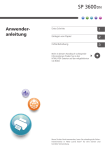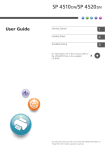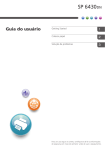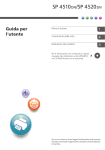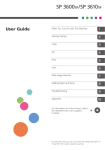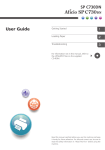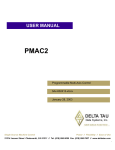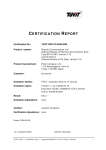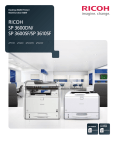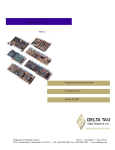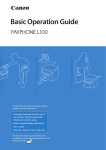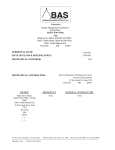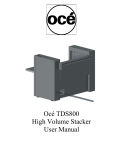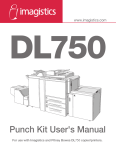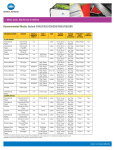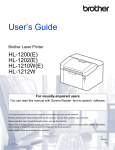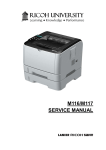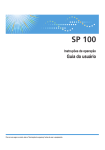Download Loading Paper - Firmware Center
Transcript
User Guide Getting Started Loading Paper Troubleshooting For information not in this manual, refer to the HTML/PDF files on the supplied CD-ROM. For safe and correct use, be sure to read the Safety Information in "Read This First" before using the machine. TABLE OF CONTENTS Manuals for This Machine.................................................................................................................................3 List of Manuals....................................................................................................................................................5 1. Getting Started Before You Start..................................................................................................................................................7 How to Read the Manuals.............................................................................................................................7 Model-Specific Information...........................................................................................................................8 List of Options.................................................................................................................................................9 Guide to Names and Functions of Components............................................................................................10 Guide to Components.................................................................................................................................10 Guide to the Names and Functions of the Control Panel.........................................................................14 Guide to the Names and Functions of the Control Panel Screen............................................................15 Turning On/Off the Power..............................................................................................................................17 Turing On the Power....................................................................................................................................17 Turning Off the Power..................................................................................................................................17 Saving Energy..............................................................................................................................................18 Displaying the Printer Configuration Screens Using the Control Panel........................................................20 Using Web Image Monitor.............................................................................................................................21 Displaying the top page..............................................................................................................................22 2. Loading Paper Paper Loading Procedure................................................................................................................................25 Paper Size Specifications................................................................................................................................26 Paper Type Specifications...............................................................................................................................29 Paper Precautions.............................................................................................................................................31 Loading Paper into Paper Trays......................................................................................................................33 When Loading Paper Larger than A4 or 81/2 × 11................................................................................36 Loading Paper into the Bypass Tray...............................................................................................................38 Loading Orientation-Fixed Paper or Two-Sided Paper................................................................................40 Loading Envelopes...........................................................................................................................................42 Specifications of Envelopes.........................................................................................................................43 Printing on Envelopes with Windows (PCL 6/PostScript 3).....................................................................45 Printing on Envelopes with Windows (PCL 5e/5c)...................................................................................45 Printing on Envelopes with Mac OS X........................................................................................................46 Paper Settings...................................................................................................................................................48 1 Specifying a Paper Size..............................................................................................................................48 Specifying a Paper Type.............................................................................................................................49 Configuring Envelope Settings Using the Control Panel...........................................................................49 3. Troubleshooting When a Panel Tone Beeps..............................................................................................................................51 When Checking the Indicator Lamps, Status Icons, and Messages on the Control Panel.........................52 Indicators......................................................................................................................................................52 If USB Connection Fails...................................................................................................................................53 When Messages Are Displayed.....................................................................................................................54 Status Messages..........................................................................................................................................54 Alert Messages............................................................................................................................................54 When You Cannot Print...................................................................................................................................58 Other Printing Problems...................................................................................................................................59 When You Cannot Print Properly................................................................................................................59 Paper Misfeeds Occur Frequently..............................................................................................................64 Additional Troubleshooting.........................................................................................................................67 The Printed Image is Different from the Image on the Computer.............................................................71 When Printer Is Not Functioning Properly..................................................................................................71 Removing Jammed Paper................................................................................................................................74 Paper Misfeed Message (A1)....................................................................................................................74 Paper Misfeed Message (A2)....................................................................................................................76 Paper Misfeed Message (B).......................................................................................................................77 Paper Misfeed Message (B) (C).................................................................................................................80 Paper Misfeed Message (Y).......................................................................................................................85 Paper Misfeed Message (Z1).....................................................................................................................87 Paper Misfeed Message (Z2).....................................................................................................................89 Trademarks.......................................................................................................................................................92 2 Manuals for This Machine Read this manual carefully before using this machine. Refer to the manuals that are relevant to what you want to do with the machine. • The method for viewing the manual depends on the manual. • Adobe® Acrobat® Reader®/Adobe Reader must be installed in order to view the manuals as PDF files. • A Web browser must be installed in order to view the HTML manuals. User Guide Summaries are provided below for the operating instructions regarding the basic usage of this machine, frequently used functions, and troubleshooting when an error message appears. Read This First Before using the machine, be sure to read the "Safety Information" section of this manual. It describes the regulations and environmental conformance. Quick Installation Guide Describes procedures from unpacking the machine to connecting it to a computer. Operating Instructions Provides detailed information about the operation of the machine in HTML format. The following are the main topics of the manual: • Getting Started • Setting Up the Printer • Loading Paper • Printing • Configuring and Managing the Printer • Troubleshooting • Maintenance and Specifications Security Guide This manual is for administrators of the machine. It explains security functions that you can use to prevent unauthorized use of the machine, data tampering, or information leakage. For enhanced security, we recommend that you first: • Install the Device Certificate. • Enable SSL (Secure Sockets Layer) Encryption. • Change the password of the administrator using Web Image Monitor. For details, see "Changing an Administrator's Password", Security Guide. 3 Be sure to read this manual when configuring the enhanced security functions or user and administrator authentication. Driver Installation Guide Explains how to install and configure the drivers. 4 List of Manuals Printed Manual Provided PDF Manual Provided HTML Manual Provided User Guide No Yes No Read This First Yes No No Quick Installation Guide Yes No No Operating Instructions No No Yes Security Guide No Yes No Driver Installation Guide No Yes No Manual Name • Operating Instructions and Driver Installation Guide are available in English, German, French, Italian, Spanish, Dutch, and Russian. 5 6 1. Getting Started This section describes the symbols used in the manuals supplied with the printer, available options, and names and functions of components. Before You Start How to Read the Manuals Symbols used in the manuals This manual uses the following symbols: Indicates points to pay attention to when using the machine, and explanations of likely causes of paper misfeeds, damage to originals, or loss of data. Be sure to read these explanations. Indicates supplementary explanations of the machine's functions, and instructions on resolving user errors. This symbol is located at the end of sections. It indicates where you can find further relevant information. [] Indicates the names of keys on the machine's display or control panels. Indicates the key sequence order you should perform using the control panel. Example: Select [System] Press [OK] (Select [System], and then press the [OK] key.) (mainly Europe and Asia) (mainly North America) Differences in the functions of Region A and Region B models are indicated by the two symbols. Read the information indicated by the symbol that corresponds to the region of the model you are using. For details about which symbol corresponds to the model you are using, see page 8 "Model-Specific Information". 7 1. Getting Started Disclaimer Contents of this manual are subject to change without prior notice. To the maximum extent permitted by applicable laws, in no event will the manufacturer be liable for any damages whatsoever arising out of failures of this machine, losses of the registered data, or the use or non-use of this product and operation manuals provided with it. Make sure that you always copy or have backups of the data registered in this machine. Documents or data might be erased due to your operational errors or malfunctions of the machine. In no event will the manufacturer be responsible for any documents created by you using this machine or any results from the data executed by you. Notes The manufacturer shall not be responsible for any damage or expense that might result from the use of parts other than genuine parts from the manufacturer with your office products. For good output quality, the manufacturer recommends that you use genuine toner from the manufacturer. Some illustrations in this manual might be slightly different from the machine. About IP addresses In this manual, "IP address" covers both IPv4 and IPv6 environments. Read the instructions that are relevant to the environment you are using. Model-Specific Information This section explains how to identify the region to which your printer belongs. There is a label on the rear of the printer, located in the position shown below. The label contains details that identify the region to which your printer belongs. Read the label. CZF090 8 Before You Start The following information is region-specific. Read the information under the symbol that corresponds to the region of your printer. (mainly Europe and Asia) If the label contains the following, your printer is a Region A model: • CODE XXXX -27 • 220–240 V (mainly North America) If the label contains the following, your printer is a Region B model: • CODE XXXX -17 • 120–127 V • Dimensions in this manual are given in two measurement units: metric and imperial. If your printer is a Region A model, refer to the metric units. If your printer is a Region B model, refer to the imperial units. List of Options This section provides a list of options for this printer and the names commonly used in this manual. Option name Description Paper Feed Unit PB1060 250-sheet paper feed unit Paper Feed Unit PB1070 500-sheet paper feed unit 9 1. Getting Started Guide to Names and Functions of Components Guide to Components • Do not obstruct the machine's vents. Doing so risks fire caused by overheated internal components. Exterior: Front view 14 1 2 3 4 13 12 5 11 10 6 9 8 7 CZF044 1. Front cover Open to access the inside of the printer and remove jammed paper. Open here to replace the print cartridge and the drum unit. 2. Tray Extension Pull this fence to prevent paper from falling off. 3. Standard tray Output is stacked here with the print side down. 4. Control panel For details, see page 14 "Guide to the Names and Functions of the Control Panel". 10 Guide to Names and Functions of Components 5. Ventilation holes Prevent overheating. 6. Front cover open button Push this button to open the front cover. 7. Paper size dial Use this dial to specify the paper size. To use a paper size that is not indicated on the paper size dial, set the dial to " ". If this is the case, set the paper size using the control panel. 8. Tray 1 Up to 250 sheets of plain paper can be loaded. For details about the sizes and types of paper that can be used, see page 26 "Paper Size Specifications" and page 29 "Paper Type Specifications". 9. Remaining paper indicator Indicates the approximate amount of paper remaining in the tray. 10. Main power switch Use this switch to turn the power on and off. For details about how to shut down the printer, see page 17 "Turning Off the Power". 11. Bypass tray open lever Push this lever to open the bypass tray. 12. Bypass tray Up to 100 sheets of plain paper can be loaded. For details about the sizes and types of paper that can be used, see page 26 "Paper Size Specifications" and page 29 "Paper Type Specifications". 13. Extender for the bypass tray Pull this extender out when loading A4 , 81/2 × 11 or larger size paper in the bypass tray. 14. Paper guides When loading paper in the bypass tray, align the paper guides flush against the paper. 11 1. Getting Started Exterior: Rear view 6 1 5 2 4 3 CZF003 1. Ventilation holes Prevent overheating. 2. Power connector Connect the power cord to the printer. Insert the other end into an electrical outlet. 3. Rear cover open lever Pull this lever to open the rear cover. 4. Rear cover Open to access the inside of the printer. Open here to replace the fusing unit or using the envelope lever. 5. USB port B Use a USB cable to connect the printer to a computer. 6. Ethernet port Use a network interface cable to connect the printer to a network. 12 Guide to Names and Functions of Components Interior: Front view 1 2 CZF002 1. Print cartridge Messages appear on the screen when the print cartridge needs to be replaced, or a new cartridge needs to be prepared. For details about the messages that appear on the screen when consumables need to be replaced, see "Replenishing and Replacing Consumables", Operating Instructions. • When you set the print cartridge apart from the drum unit, pull down the lever on the right side of the print cartridge, and then pull the print cartridge out. 2. Drum unit Messages appear on the screen when the drum unit needs to be replaced, or a new drum unit needs to be prepared. For details about the messages that appear on the screen when consumables need to be replaced, see "Replenishing and Replacing Consumables", Operating Instructions. Interior: Rear view 1 CZF004 13 1. Getting Started 1. Fusing unit Messages appear on the screen when the fusing unit needs to be replaced, or a new fusing unit needs to be prepared. For details about the messages that appear on the screen when consumables need to be replaced, see "Replenishing and Replacing Consumables", Operating Instructions. The fusing unit is included in Maintenance Kit. Guide to the Names and Functions of the Control Panel This illustration shows the control panel of the printer. 1 2 10 3 9 4 8 5 6 7 CZF041 1. Display Displays current printer status and error messages. 2. Selection keys Correspond to the function items at the bottom line on the display. Example: When this manual instructs you to press [Supplies], press the selection key on the right below the initial screen. 14 Guide to Names and Functions of Components 3. [Menu] key Press this key to configure and check the current printer settings. Press to change the default settings to meet your requirements. See page 20 "Displaying the Printer Configuration Screens Using the Control Panel". 4. [Job Reset] key Press to cancel the current print job. 5. Power indicator Lights up when the printer is ready to receive data from a computer. Flashes when the printer is warming up or receiving data. It is unlit when the power is off. 6. Alert indicator Lights up or flashes when a printer error occurs. Steady red: printing is not possible, or is possible but print quality cannot be ensured. Flashing yellow: the printer will soon require maintenance or a replacement consumable such as print cartridge. Follow the instructions that appear on the display. 7. Data in indicator Flashes when the printer is receiving data from a computer. The data in indicator is lit if there is data to be printed. 8. [Escape] key Press this key to cancel an operation or return to the previous display. 9. [OK] key Use this key to confirm settings or setting values, or move to the next menu level. 10. Scroll keys Press these keys to move the cursor in each direction. When the [ ] [ ] [ ] [ ] keys appear in this manual, press the applicable key for the direction that you want to move the cursor. Guide to the Names and Functions of the Control Panel Screen 1 2 3 CZF903 15 1. Getting Started 1. Operational Status or Messages Displays the printer status and messages. 2. [JobReset] Press to cancel the current print job. 3. [Supplies] Press to display the information about printer supplies. 16 Turning On/Off the Power Turning On/Off the Power This section explains how to turn on/off the printer. Turing On the Power 1. Make sure the power cord is firmly plugged into the wall outlet. 2. Push the main power switch. CZF031 The power indicator turns on. Turning Off the Power • When disconnecting the power cord from the wall outlet, always pull the plug, not the cord. Pulling the cord can damage the power cord. Use of damaged power cords could result in fire or electric shock. • Do not press and hold the main power switch when turning off the printer. Doing so shuts down the printer forcefully and may damage the memory, causing a malfunction of the printer. • Before unplugging the power cord plug, turn off the power switch and make sure the power switch indicator turns off. Not doing so may result in damage to the memory, leading to a malfunction. • Do not turn off the power while the printer is in operation. 17 1. Getting Started 1. Push the main power switch. CZF031 The main power is turned off automatically when the shutdown process is complete. If the machine does not turn off within 10 minutes, contact your service representative. Saving Energy This printer has the following energy saving functions: Sleep mode The printer will automatically go into Sleep mode when a certain period of time elapses following the last operation or print. The printer can print jobs from computers. You can change the amount of time that the printer waits before switching to Sleep mode. For details about setting [Sleep Mode], see "Timer Settings", Operating Instructions. To exit Sleep mode, do one of the following: • Press one of the keys on the control panel • Start print jobs • The energy saving functions will not activate when: • A warning message is displayed • The service call message is displayed • Paper is jammed • The printer's covers are opened • Toner is being replenished • The printer settings screen is displayed • Fixed warm-up is in progress • Data is being processed 18 Turning On/Off the Power • Operations are suspended during printing • The Data In indicator is on or flashing • The printer consumes less energy when in Sleep mode, but it takes longer to start printing. 19 1. Getting Started Displaying the Printer Configuration Screens Using the Control Panel The configuration screens allow you to change or set defaults. • If an authentication screen appears, enter the password. For details, contact your administrator. 1. Press the [Menu] key. CZF042 2. Select the settings you want to change. Press the [ ] or [ ] key to select the next or previous items. 3. Press the [OK] key. • Any changes you make with configuration screens remain in effect even if the main power switch is turned off. • To cancel changes made to settings and return to the initial display, press the [Escape] key. 20 Using Web Image Monitor Using Web Image Monitor Using Web Image Monitor, you can check the printer status and change settings. Available operations The following operations can be remotely performed using Web Image Monitor from a client computer. • Displaying printer status or settings • Configuring printer settings • Configuring network protocol settings Configuring the printer To perform the operations from Web Image Monitor, TCP/IP is required. After the printer is configured to use TCP/IP, operations from Web Image Monitor become available. Recommended Web browser • Windows: Internet Explorer 6.0/7.0/8.0 Firefox 2.0 or higher • Mac OS: Safari 3.0 or higher Firefox 2.0 or higher Web Image Monitor supports screen reader software. We recommend JAWS 7.0 or a later version. • Display and operation problems may occur if you do not enable JavaScript and cookies, or if you are using a non-recommended Web browser. • If you are using a proxy server, change the Web browser settings. Contact your administrator for information about the settings. • We recommend using Web Image Monitor in the same network. • If the printer is firewall-protected, it cannot be accessed from computers outside the firewall. • If the printer under DHCP is used, the IP address may be changed automatically by the DHCP server settings. Enable DDNS setting on the printer, and then connect using the printer's host name. Alternatively, set a static IP address to the DHCP server. • If the HTTP port is disabled, a connection to the printer using the printer's URL cannot be established. SSL settings must be enabled on this printer. For details, contact your network administrator. • If Firefox is used, fonts and colors may be different, or tables may not appear properly configured. 21 1. Getting Started • When using a host name under Windows Server 2003/2003 R2/2008/2008 R2/2012 with IPv6 protocol, perform host name resolution using an external DNS server. The host file cannot be used. • To use JAWS 7.0 under Web Image Monitor, you must be running Windows and Internet Explorer 6.0 or a later version. • If you are using Internet Explorer 8.0 or higher, downloading will be slower than with other browsers. To download faster with Internet Explorer 8.0 or higher, open the browser's [Internet Options] menu and register the printer's URL as a trusted site, and then disable SmartScreen filter for trusted sites. For details about these settings, see the Internet Explorer Help files. • You can access Web Image Monitor more quickly by registering the printer's URL as a bookmark. Note that the URL you register must be the URL of the top page, which is the page that appears before login. If you register the URL of a page that appears after login, Web Image Monitor will not open properly from the bookmark. • When you configure settings using Web Image Monitor, do not log in from the control panel. The settings you have configured using Web Image Monitor may become invalid. Displaying the top page There are two modes available with Web Image Monitor: guest mode and administrator mode. Displayed items may differ depending on the printer type. Guest mode This mode requires no login to enter. In the guest mode, the printer status, settings, and print job status can be viewed, but the printer settings cannot be changed. Administrator mode This mode requires an administrator login to enter. In the administrator mode, you can configure various printer settings. • When entering an IPv4 address, do not begin segments with zeros. For example: If the address is "192.168.001.010", you must enter it as "192.168.1.10". 1. Start your Web browser. 2. Enter "http://(printer's IP address or host name)/" in your Web browser's address bar. The top page of Web Image Monitor appears. If the printer's host name has been registered on the DNS or WINS server, you can enter it. When setting SSL, a protocol for encrypted communication, under the environment in which server authentication is issued, enter "https://(printer's IP address or host name)/". 22 Using Web Image Monitor 3. To log in to Web Image Monitor in the administrator mode, click [Login] on the top page. The window for entering the login user name and password appears. 4. Enter your login user name and password, and then click [Login]. For details about the login user name and password, contact your administrator. Depending on the configuration of your Web browser, the login user name and password might be saved. If you do not want to save them, configure your Web browser's settings so that this information is not saved. 2 3 4 5 1 6 7 CZF906 1. Menu area Displays the content of a selected menu item. 2. Header area Displays the dialog box for switching to the user mode and administrator mode and the menu for each mode. Also displays the link to Help. 3. Help Clicking the Help button ( Clicking the Help button ( ) in the header area displays the contents of Help. ) in the work area displays the Help for the setting items in the work area. An internet connection is required to view the contents of Help. 4. Refresh Click at the upper right in the work area to update the printer information. Click the Web browser's [Refresh] button to refresh the entire browser screen. 5. FAQs/Knowledge Base Click to view the Frequently Asked Questions. An internet connection is required to view the Frequently Asked Questions. 6. Basic Information area Displays the basic information of the printer. 7. Work area Displays the contents of the item selected in the menu area. 23 1. Getting Started 24 2. Loading Paper This chapter describes available trays for each paper size and type, and explains how to load paper in paper trays. Paper Loading Procedure To achieve the print results you expect, it is important to select an appropriate input tray according to the size, type, and weight of the paper you want to use for printing. You also need to specify the paper size and type properly using the control panel or Web Image Monitor, and/or the paper size dial on the tray. Follow the procedure below to load paper. 1. Check the paper tray available for the size, type, and weight of the paper you want to use for printing. For details about available paper trays for each paper size and type, see page 26 "Paper Size Specifications" and page 29 "Paper Type Specifications". 2. Change the paper size and type settings for the tray you selected. Use the control panel of the printer or Web Image Monitor to change the paper size and type. When loading paper into Trays 1 and 2, adjust the paper size dial on the trays. For details about changing paper settings using the control panel, see page 48 "Paper Settings". 3. Load paper into the tray. For details about loading paper, see page 33 "Loading Paper into Paper Trays" or page 38 "Loading Paper into the Bypass Tray". For details about loading envelopes, see page 42 "Loading Envelopes". 25 2. Loading Paper Paper Size Specifications The following tables show the paper sizes that can be loaded in each paper tray. The "Paper size" column shows the names of paper sizes and their dimensions in millimeters and inches. The and icons indicate the paper orientation in relation to the printer body. The letters in the tables indicate the following: • A: Select the paper size using the control panel. • B: Select the paper size using the paper size dial on the tray. • C: Set the paper size dial on the tray to " ", and select the paper size with the control panel. • : You can print on both sides of paper. • -: Not supported Metric sizes Paper size name Bypass tray Tray 1 Tray 2 210 × 297 mm A B B 148 × 210 mm A B B - A5 148 × 210 mm A C C - A6 105 × 148 mm A B B - B5 182 × 257 mm A C C - B6 128 × 182 mm A C C - B6 128 × 182 mm A - - - C5 Env 162 × 229 mm A C - - C6 Env 114 × 162 mm A C - - DL Env 110 × 220 mm A C - - 16K 195 × 267 mm A C C - A4 A5 * Actual size Two-sided * While a print job is performed on paper that is loaded vertically, smearing may occur near the edges of the printed paper. If this happens, set the paper horizontally and print again. Imperial sizes Paper size name 81/2 × 14 26 Actual size 8.5" × 14" Bypass tray Tray 1 Tray 2 A B B Two-sided Paper Size Specifications Paper size name Actual size Bypass tray Tray 1 Tray 2 Two-sided 81/2 × 13 8.5" × 13" A C C 81/2 × 11 8.5" × 11" A B B 81/4 × 14 8.25" × 14" A C C 81/4 × 13 8.25" × 13" A C C 8 × 13 8" × 13" A C C 8 × 101/2 8" × 10.5" A C C - 8 × 10 8" × 10" A C C - 71/4 × 101/2 7.25" × 10.5" A C C - 5.5" × 8.5" A B B - 51/2 × 81/2 5.5" × 8.5" A - - - 41/8 × 91/2 4.125" × 9.5" A C - - 37/8 × 71/2 3.875" × 7.5" A C - - 51/2 × 81/2 * * While a print job is performed on paper that is loaded vertically, smearing may occur near the edges of the printed paper. If this happens, set the paper horizontally and print again. Use the bypass tray when printing on paper that is set horizontally. Custom Size Specifications You can also load custom size paper by specifying horizontal and vertical sizes. The following tables show the custom paper sizes that can be loaded in each tray. Metric sizes Tray Horizontal size (One-sided) Vertical size (One-sided) Horizontal size (Two-sided) Vertical size (Two-sided) Bypass tray 60.0 to 216.0 mm 127.0 to 900.0 mm 100.0 to 216.0 mm 279.0 to 356.0 mm Trays 1, 2 100.0 to 216.0 mm 148.0 to 356.0 mm 100.0 to 216.0 mm 279.0 to 356.0 mm 27 2. Loading Paper Imperial sizes Tray 28 Horizontal size (One-sided) Vertical size (One-sided) Horizontal size (Two-sided) Vertical size (Two-sided) Bypass tray 2.37 to 8.50" 5.00 to 35.43" 3.94 to 8.50" 10.99 to 14.01" Trays 1, 2 3.94 to 8.50" 5.83 to 14.01" 3.94 to 8.50" 10.99 to 14.01" Paper Type Specifications Paper Type Specifications The following table show the paper types that can be loaded in each tray. See “Paper weight” table for the actual paper weight indicated by numbers in the “Paper weight No.” column. Use both tables to specify the correct paper type for the paper you are using. The letters in the tables indicate the following: • A: Supported • : You can print on both sides of paper. • -: Not supported Paper weight No. Bypass tray Tray 1 Tray 2 Thin Paper 1 A A A Plain Paper 2 A A A Plain Paper 2 3 A A A Middle Thick Paper 4 A A A Thick Paper 1 5 A A A Thick Paper 2 6 A A A Recycled Paper 2 to 3 A A A Color Paper 2 to 3 A A A Special Paper 1 -*1 A A A Special Paper 2 -*1 A A A Letterhead Paper 1 to 6 A A A Preprinted Paper 2 to 3 A A A - -*1 A - - - Label Paper 3 to 5 A A A - Envelope 3 to 6 A A - - Paper type Transparency Two-sided - - 29 2. Loading Paper Paper weight No. Paper weight 1 52–65 g/m2 (14–18 lb. BOND) 2 66–74 g/m2 (18–20 lb. BOND) 3 75–90 g/m2 (20–24 lb. BOND) 4 91–105 g/m2 (24–28 lb. BOND) 5 106–130 g/m2 (28–35 lb. BOND) 6 131–162 g/m2 (35 lb. BOND–90 lb. INDEX) *1 It is not necessary to specify the paper weight for this paper type. • If [Thick Paper 2] is selected, the print speed may change. 30 Paper Precautions Paper Precautions • Do not attempt to print on stapled sheets, aluminum foil, carbon paper, or any kind of conductive paper. Doing so risks fire. Precautions • Recommended paper: Paper with calcium carbonate (CaCO3) ratio of 15% or less. • To prevent multiple sheets from being fed at once, fan the paper before loading it. • If you load paper when only a few sheets of paper remain in the tray, multiple sheet feeding may occur. Remove any remaining paper, stack them with the new sheets of paper, and then fan the entire stack before loading it into the tray. • Straighten curled or warped paper before loading. • For details about available paper sizes and types for each paper tray, see page 26 "Paper Size Specifications" and page 29 "Paper Type Specifications". • Depending on the environment where the printer is being used, you might at times hear a rustling noise from paper moving through the printer. This noise does not indicate a malfunction. Unusable Paper To prevent errors and misfeeds, do not use: • Paper for inkjet printers, thermal fax paper, art paper, paper with perforated lines, hemmededge paper, or window envelopes • Bent, folded, or creased paper, perforated paper, slippery paper, torn paper, rough paper, thin paper with little stiffness, and paper with a dusty surface • Errors can occur if you print onto sides that are already printed. Be sure to print onto blank sides only. • Even supported types of paper may cause paper jams or malfunctions if they have been improperly stored. • If you print onto rough grain paper, the output image might be blurred. • Do not load sheets that have already been printed by another printer. Paper Storage When storing paper, the following precautions should always be followed: • Do not store paper where it will be exposed to direct sunlight. • Avoid storing paper in humid areas (humidity: 70% or less). • Store on a flat surface. 31 2. Loading Paper • Do not store paper vertically. • Once opened, store paper in plastic bags. Print Area The following shows the recommended print area for paper printed with this printer: 2 4 4 3 1 3 CEC244 1. Print area 2. Feed direction 3. 4.2 mm (0.2 inches) 4. 4.2 mm (0.2 inches) • The print area may vary depending on the paper size, printer language, and printer driver settings. • Depending on the printer driver settings, you may be able to print outside the recommended print area. However, the actual output may not come out as desired, or a paper feed problem may occur. 32 Loading Paper into Paper Trays Loading Paper into Paper Trays In the following example procedure, paper is loaded into Tray 1. • When loading paper, take care not to trap or injure your fingers. • When using the envelope lever, take care not to trap or injure your fingers. • For details about trays that can be loaded for each paper size and type, see page 26 "Paper Size Specifications" and page 29 "Paper Type Specifications". • Be sure to select the correct paper size and feed direction using the paper size dial on the tray. Otherwise, the printer might be damaged, or printing problems might occur. • Make sure the paper stack does not exceed the upper limit mark inside the paper tray. Excessive stacking can cause paper jams. • If paper jams occur frequently, flip the paper stack in the tray. • Do not mix different types of paper in the same paper tray. • After loading paper, specify the paper size using the control panel or paper size dial, and paper type using the control panel. When printing a document, specify the same paper size and type in the printer driver as specified on the printer. • Do not move the side paper guides and end paper guide forcefully. Doing so may damage the tray. • When loading label paper, load it one by one. • The envelope lever is kept down by the factory default. Before printing with paper, except for envelopes, be sure to raise the envelope lever all the way up. CYN916 33 2. Loading Paper 1. Pull out the paper tray carefully. Adjust the paper size dial to match the size and feed direction of paper in the paper tray. CZF027 2. Pull the tray carefully until it stops, lift the front side of the tray, and then pull it out of the printer. CZF028 Place the tray on a flat surface. 3. Squeeze the clip on the side paper guide and slide it to match the paper size. CXC613 34 Loading Paper into Paper Trays 4. Squeeze the end guide and slide it inward to match the standard size. CXC614 5. Fan the paper before loading it in the tray. CBK254 6. Load the new paper stack print side down. Make sure paper is not stacked higher than the upper limit (upper line) marked inside the tray. CXC666 7. Adjust the paper guides to close any gaps. Do not move paper loaded in the tray more than a few millimeters. Moving the loaded paper excessively may cause damage to paper edges on the openings of the tray's lifting plate, resulting in sheets being folded or becoming jammed. 35 2. Loading Paper 8. Lift the front side of the tray, and then slide it into the printer carefully until it stops. CZF029 To avoid paper jams, make sure the tray is securely inserted. • When loading paper larger than A4 or 81/2 × 11 into Tray 1, extend the tray. For details, see page 36 "When Loading Paper Larger than A4 or 81/2 × 11". • Letterhead paper must be loaded in a specific orientation. For details, see page 40 "Loading Orientation-Fixed Paper or Two-Sided Paper". • You can load envelopes into Tray 1. Envelopes must be loaded in a specific orientation. For details, see page 42 "Loading Envelopes". When Loading Paper Larger than A4 or 81/2 × 11 When loading paper larger than A4 or 81/2 × 11 into Tray 1, extend the tray. 1. Pull the tray out of the printer. For details, see Steps 1 and 2 on page 33 "Loading Paper into Paper Trays". 2. Slide the catches inwards to unlock the tray, and then slide the tray until it stops. 1 2 1 2 CXC607 36 Loading Paper into Paper Trays 3. Return the catches to the positions where they lock. CXC608 • When loading A4 , 81/2 × 11 , or smaller paper, do not extend the tray. Otherwise, a paper jam may occur. 37 2. Loading Paper Loading Paper into the Bypass Tray • For details about trays that can be loaded for each paper size and type, see page 26 "Paper Size Specifications" and page 29 "Paper Type Specifications". • Make sure the paper stack does not exceed the upper limit mark. Excessive stacking can cause paper jams. • Do not mix different types of paper. • After loading paper, specify the paper size and type using the control panel. When printing a document, specify the same paper size and type in the printer driver as specified on the printer. • When loading label paper, load it one by one. 1. While pressing and holding the bypass tray open lever in the upper center of the bypass tray, pull the tray open. CZF036 Pull the extender out when loading paper larger than A4 or 81/2 × 11 . CZF037 38 Loading Paper into the Bypass Tray 2. Slide both sides of the paper guide outward, and then load paper print side up until it stops. 1 2 1 CZF038 3. Adjust both sides of the paper guide to match the paper width. CZF039 • When using the bypass tray, it is recommended that you set the paper direction to . • Letterhead paper must be loaded in a specific orientation. For details, see page 40 "Loading Orientation-Fixed Paper or Two-Sided Paper". • You can load envelopes into the bypass tray. Envelopes must be loaded in a specific orientation. For details, see page 42 "Loading Envelopes". 39 2. Loading Paper Loading Orientation-Fixed Paper or Two-Sided Paper Orientation-fixed (top to bottom) or two-sided paper (for example, letterhead paper, punched paper, or copied paper) might not print correctly, depending on how the paper is placed. Settings using the control panel Set [Letterhead Setting] to [Auto Detect], and then place the paper as shown in the table below. For details about [Letterhead Setting], see "System", Operating Instructions. Paper orientation The meanings of the icons are as follows: Icon Meaning Place or load paper printed side face up. Place or load paper printed side face down. Print side Trays 1, 2 Bypass tray One-sided Two-sided • To print on letterhead paper when [Letterhead Setting] is set to [Auto Detect], you must specify [Letterhead] for the paper type in the printer driver's settings. 40 Loading Orientation-Fixed Paper or Two-Sided Paper • For details about how to make two-sided prints, see "Printing on Both Sides of a Page", Operating Instructions. 41 2. Loading Paper Loading Envelopes This section explains various details about and recommendations concerning envelopes. • The inside of the machine could be very hot. Do not touch the parts with a label indicating the "hot surface." Otherwise, an injury might occur. • Some of this machine's internal components get very hot. For this reason, take care when removing misfed paper. Not doing so could result in burns. • When using the envelope lever, take care not to trap or injure your fingers. Before loading envelopes, be sure to lower the envelope lever. 1. Open the rear cover. CZF112 2. Lower the envelope lever all the way down. CZF113 42 Loading Envelopes 3. Close the rear cover. CZF114 • Be sure to raise the envelope lever after printing on envelopes. Specifications of Envelopes • Do not use window envelopes. • Envelopes, especially those with glue on their flaps, may stick together. Fan the envelopes to separate them before loading. If the envelopes still stick together, load them one by one. For the envelope types that can be used with this printer, see page 26 "Paper Size Specifications" and page 29 "Paper Type Specifications". • Misfeeds might occur depending on the length and shape of the flaps. • Before loading envelopes, press down on them to remove any air from inside, flattening out all four edges. If they are bent or curled, flattening their leading edges (the edge going into the printer) by running a pencil or ruler across them. The method for loading envelopes varies depending on the orientation of the envelopes. Be sure to load envelopes with the correct orientation. 43 2. Loading Paper Orientation Paper tray 1 Bypass tray Envelopes • Flaps: closed • Flaps: closed • Bottom side of envelopes: toward the right of the printer • Bottom side of envelopes: toward the right of the printer • Side to be printed: face up • Side to be printed: face down When loading envelopes, use both the control panel and the printer driver to select "Envelope" for the paper type and specify the thickness of the envelopes. For details, see page 49 "Configuring Envelope Settings Using the Control Panel". Recommended envelopes For details about recommended envelopes, contact your local dealer. The size of envelopes that you can load depends on the tray in which you load them. For details, see page 26 "Paper Size Specifications". • Load only one size and type of envelope at a time. • The duplex function cannot be used with envelopes. • Straighten any curls within 2 mm (0.1 inch) upward and 0 mm (0 inches) downward on the tray before loading. • To achieve better output quality, it is recommended that you set the right, left, top, and bottom print margin to at least 15 mm (0.6 inches) each. • The output quality on envelopes may be uneven if parts of an envelope have differing thicknesses. Print one or two envelopes to check the print quality. • When printing onto envelopes, the print speed is slower than usual. • Flatten out prints if they are creased or curled. • Check that the envelopes are not damp. • High temperature and high humidity conditions can reduce print quality and cause envelopes to become creased. • Depending on the environment, printing on envelopes may wrinkle them even if they are the recommended envelopes. 44 Loading Envelopes • Certain types of envelopes might be output creased, dirtied, or misprinted. If you are printing a solid color on an envelope, lines may appear where the overlapped edges of the envelope make it thicker. Printing on Envelopes with Windows (PCL 6/PostScript 3) 1. After creating a document, open the [Printing Preferences] dialog box in the document's native application. 2. Click the [Detailed Settings] tab. 3. In the "Menu:" box, click the [Basic] icon, and then configure the following settings: • Document Size: Select the envelope size. 4. In the "Menu:" box, click the [Paper] icon, and then configure the following settings: • Input Tray: Select the paper tray where the envelopes are loaded. • Paper Type: Select [Envelope]. Change any other print settings as necessary. For details, see the printer driver's Help. 5. Click [OK]. 6. Start printing from the application's [Print] dialog box. • Configure the paper settings appropriately using both the printer driver and the control panel. For details about settings using the control panel, see page 49 "Configuring Envelope Settings Using the Control Panel". • Envelopes must be loaded in a specific orientation. For details, see page 42 "Loading Envelopes". Printing on Envelopes with Windows (PCL 5e/5c) 1. After creating a document, open the [Printing Preferences] dialog box in the document's native application. 45 2. Loading Paper 2. Click the [Paper] tab, and then configure the following settings: • Input Tray: Select the paper tray where the envelopes are loaded. • Document Size: Select the envelope size. • Type: Select [Envelope]. Change any other print settings as necessary. For details, see the printer driver's Help. 3. Click [OK]. 4. Start printing from the application's [Print] dialog box. • Configure the paper settings appropriately using both the printer driver and the control panel. For details about settings using the control panel, see page 49 "Configuring Envelope Settings Using the Control Panel". • Envelopes must be loaded in a specific orientation. For details, see page 42 "Loading Envelopes". Printing on Envelopes with Mac OS X 1. After creating a document, open the printing preferences screen in the document's native application. 2. Configure the following settings: • Two-Sided: Clear the check box. • Paper Size: Select the envelope size. • Orientation: Select the orientation of the envelope. 3. Select [Paper Feed] in the pop-up menu. 4. Select the paper tray where the envelopes are loaded. 5. Select [Printer Features] in the pop-up menu. 46 Loading Envelopes 6. Switch the "Feature Sets:" menu to configure the following settings: • Paper Type: Select [Envelope]. 7. Change any other print settings as necessary. 8. Start printing from the application's printing preferences screen. • Configure the paper settings appropriately using both the printer driver and the control panel. For details about settings using the control panel, see page 49 "Configuring Envelope Settings Using the Control Panel". • Envelopes must be loaded in a specific orientation. For details, see page 42 "Loading Envelopes". 47 2. Loading Paper Paper Settings This section explains how to specify paper size and type using the control panel. • When [Tray Setting Priority] is set to [Machine Setting(s)], the paper settings configured using the printer's control panel have priority over the settings specified in the printer driver or commands. For details, see "System", Operating Instructions. Specifying a Paper Size • To use the paper size and feed direction other than those indicated on the paper size dial, set the dial to " ", and set the paper size using the control panel. • To use custom size paper, be sure to specify the paper size using the control panel and the printer driver. • The printer cannot print on custom size paper if the application does not support custom size paper. Specifying Standard Size Paper Press the [Menu] key, and then select the setting items using the [ ] or [ ] key. 1. Select [Tray Paper Settings] Press [OK] 2. Select [Printer Bypass Paper Size] or [Paper Size: (tray name)] 3. Select the size of the paper set in the specified tray Press [OK] Press [OK] • For details about the available paper size, see page 26 "Paper Size Specifications". Specifying Custom Size Paper Press the [Menu] key, and then select the setting items using the [ ] or [ ] key. 1. Select [Tray Paper Settings] Press [OK] 2. Select [Printer Bypass Paper Size] or [Paper Size: (tray name)] 3. Select [Custom Size] Press [OK] 4. Enter the horizontal value 5. Enter the vertical value 48 Press [OK] Press [OK] Press [OK] Paper Settings • For details about the available paper size, see page 26 "Paper Size Specifications". Specifying a Paper Type You can improve printer performance by selecting the optimum paper type for the tray. Press the [Menu] key, and then select the setting items using the [ ] or [ ] key. 1. Select [Tray Paper Settings] Press [OK] 2. Select [Paper Type: (tray name)] Press [OK] 3. Select the type of the paper set in the specified tray Press [OK] 4. If you have selected [Recycled Paper], [Color Paper], [Letterhead], [Label Paper], [Envelope], or [Preprinted Paper] for the paper type, press [Escape] 5. Select [Maintenance] Press [OK] 6. Select the paper thickness setting for the specified paper type 7. Select the tray where the specified type of paper is loaded Press [OK] Press [OK] Press [OK] 8. Select the paper thickness • For details about the available paper type, see page 29 "Paper Type Specifications". Configuring Envelope Settings Using the Control Panel When printing on envelopes, load envelopes in bypass tray or Tray 1, and then follow the procedure below to specify envelope type and thickness. Press the [Menu] key, and then select the setting items using the [ ] or [ ] key. 1. Select [Tray Paper Settings] Press [OK] 2. Select [Printer Bypass Paper Size] or [Paper Size: Tray 1] 3. Select the envelope type Press [OK] 4. Select [Paper Type: (tray name)] 5. Select [Envelope] Press [OK] Press [OK] Press [OK] 6. Press [Escape] 7. Select [Maintenance] Press [OK] 8. Select [Envelope Setting] Press [OK] 9. Select the source tray for which you want to change the paper thickness 10. Select the paper thickness Press [OK] Press [OK] 49 2. Loading Paper • For details about the envelope types that can be loaded in each tray, see page 26 "Paper Size Specifications" and page 29 "Paper Type Specifications". • For details about how to load envelopes, see page 42 "Loading Envelopes". • Configure the paper settings appropriately using both the printer driver and the control panel. For details about paper settings using the printer driver, see page 45 "Printing on Envelopes with Windows (PCL 6/PostScript 3)", page 45 "Printing on Envelopes with Windows (PCL 5e/5c)", or page 46 "Printing on Envelopes with Mac OS X". 50 3. Troubleshooting This chapter provides solutions to common problems and it also explains how to correct unwanted print results. When a Panel Tone Beeps The following table describes various beep patterns that the printer produces to alert users about printer conditions and the meaning of each beep pattern. Beep pattern Meaning Causes Single short beep Panel/screen input accepted. A control panel key was pressed. Two long beeps Printer has warmed up. When the power is turned on or the printer exits Sleep mode, the printer has fully warmed up and is ready for use. Five long beeps repeated four times. Soft alert An error message appears on the control panel if there is no tray for the selected paper size or the tray is empty. Five short beeps repeated five times. Strong alert The printer requires user attention because paper has jammed, the toner needs replenishing, or other problems have occurred. • Beep alerts cannot be muted. If the printer's covers are opened and closed repeatedly within a short space of time during an alert indicating a paper jam or insufficient toner, a beep alert might continue, even after normal status has resumed. • You can enable or disable beep alerts. For details, see "General Features", Operating Instructions. 51 3. Troubleshooting When Checking the Indicator Lamps, Status Icons, and Messages on the Control Panel Indicators This section describes the indicators displayed when the printer requires the user to remove misfed paper, to add paper, or to perform other procedures. Indicator : Paper Misfeed indicator Status Appears when a paper misfeed occurs. For details about removing jammed paper, see page 74 "Removing Jammed Paper". : Load Paper indicator Appears when paper runs out. For details about loading paper, see page 25 "Loading Paper". : Add Toner indicator Appears when toner runs out. For details about adding toner, see "Replacing the Print Cartridge", Operating Instructions. 52 : Service Call indicator Appears when the printer is malfunctioning or requires maintenance. : Cover Open indicator Appears when one or more covers of the printer are open. If USB Connection Fails If USB Connection Fails Problem Causes Solutions The printer is not automatically recognized. The USB cable is not connected properly. Disconnect the USB cable, turn off the printer, and then turn it on again. When the printer has fully booted up, reconnect the USB cable. Windows has already configured the USB settings. Check whether or not the computer has identified the printer as an unsupported device. Open Windows' Device Manager, and then, under [Universal Serial Bus controllers], remove any conflicting devices. A [!] or [?] icon is displayed for conflicting devices. Take care not to accidentally remove required devices. For details, see Windows Help. 53 3. Troubleshooting When Messages Are Displayed This section describes the main messages that appear on the display panel and printed error logs and reports. If other messages appear, follow their instructions. Status Messages Message Status "Loading toner" The machine is loading toner. "Please wait..." This message may appear for a few seconds. It means the printer is initializing, replenishing toner, or performing maintenance operations. Wait a while. "Printing..." The printer is printing. Wait a while. "Ready" This is the default ready message. The printer is ready for use. No action is required. "Resetting Job" The printer is resetting the print job. Wait a while. "Setting change..." The printer is applying the changes made to its settings. Wait a while. "Updating Certificate..." The printer is updating the @Remote certificate. Turn the power off, and then turn it on again. "Waiting for print data..." The printer is waiting for the next data to print. Wait a while. Alert Messages Message 54 Cause Solution " (A1) Remove misfeed in Trays. Opn & cls Frt. Cov." Open the front cover and remove the jammed paper from the paper feed path. For details, see page 74 "Removing Jammed Paper". " (A2) Open Front Cover and remove the paper." Remove the jammed paper from the bypass tray. To reset the error, open the front cover and then close it. For details, see page 74 "Removing Jammed Paper". When Messages Are Displayed Message Cause Solution " (B) Open Front Cover and remove the paper." Open the front cover and remove the jammed paper from the internal paper feed path. For details, see page 74 "Removing Jammed Paper". " (B) (C) Open Front/Rear Cover and remove misfeed." Open the front cover and remove any jammed paper from the internal paper feed path. For details, see page 74 "Removing Jammed Paper". " (Y1) Remove misfeed in Tray Open Tray 2 and remove the 2. Opn & cls Frt. Cov." jammed paper. To reset the error, open the front cover and then close it. For details, see page 74 "Removing Jammed Paper". " (Z1) Open Rear Cover and remove misfeed" Open the rear cover and remove the jammed paper from the paper duplex unit. For details, see page 74 "Removing Jammed Paper". " (Z2) Opn Tray1/R.Cov & remove ppr. Opn & cls F.Cov" Open Tray 1 and the rear cover, and then remove the jammed paper. To reset the error, open the front cover and then close it. For details, see page 74 "Removing Jammed Paper". " Toner is almost empty." The print cartridge is almost empty. For details, see "Replacing the Print Cartridge", Operating Instructions. " Add toner. Replace Toner Cartridge." The toner has run out. Replace the print cartridge. For details, see "Replacing the Print Cartridge", Operating Instructions. "@Remote Cert. update failed" Updating the @Remote certificate failed. Turn the printer off, and then turn it on again. If the problem persists, contact your sales or service representative. "Cannot connect=>Comm.Serv. Check proxy user/password." The proxy user name or password is incorrect. Check the proxy server settings, and then change the user name and/or password if they are incorrect. 55 3. Troubleshooting Message Cause Solution "Change (Tray name) to the following settings:" The size of the paper in the tray does not match the paper size specified in the printer driver. Press [Change] to change the paper size and type settings of the tray, as indicated on the screen, and then load the appropriate paper in the tray. Otherwise, press [JobReset] to reset the job, or press [Form Feed] to force printing by specifying another tray. "Cover Open. Please close the indicated cover." A cover of the printer is open. Close the cover as indicated on the control panel. "Duplex mode is in off position for (tray name)" The duplex mode for the indicated tray is not available. Press [Change] to change the tray setting to allow duplex printing, or press [Job Reset] to reset the job. Otherwise, press [Form Feed] to print on one side of a sheet. "Enter password." User Restriction is enabled. Contact your administrator for the password. "Failed to connect to server for Remote Diagnostics." The printer cannot communicate with Remote Communication Gate. Check the connection to the Remote Server Gate. "Independent-supply toner" Independent-supply toner is set. Use the toner recommended for this printer. "Load paper in (tray name)" There is no paper in the specified tray. Change the settings of the printer driver, and then print the file again. Load the specified paper in the tray. 56 "Replacmnt Requrd Maint. Kit" You need to replace the maintenance kit. For details, see "Replacing Other Consumables", Operating Instructions. "Replcmnt Requrd Drum Unit" You need to replace the drum unit. For details, see "Replacing Other Consumables", Operating Instructions. When Messages Are Displayed Message Cause Solution "Repl Requrd Soon Maint. Kit" You will need to replace the maintenance kit soon. Contact your sales or service representative to obtain a new unit. "Rplcmnt Rqrd Soon:Drum Unit" You will need to replace the drum unit soon. Contact your sales or service representative to obtain a new unit. "Set the Drum Unit correctly." The drum unit may not be installed correctly. Turn the printer off, and then install the drum unit again. "Set the Maintenance Kit correctly." The fusing unit may have not been installed correctly. Turn the printer off, and then install the fusing unit again. If the message continues to appear after the unit is installed again, contact your sales or service representative. "Set the Toner Cartridge correctly." The print cartridge may have not been installed correctly. Turn the printer off, and install the print cartridge again. "Supply order has failed." The automatic supply order failed. The message indicates the printer tried to order the supplies. "Waste Toner almost full" The print cartridge must be replaced when the life of the waste toner is ending. Prepare a new print cartridge. "Waste Toner full" The waste toner is full. Replace the print cartridge. For details, see page 74 "Removing Jammed Paper". 57 3. Troubleshooting When You Cannot Print Problem Cause Printing does not start. The power is off. For details about how to turn on the main power switch, see page 17 "Turning On/Off the Power". Printing does not start. The cause is displayed on the screen of the control panel. Check the error message or warning status on the display panel, and then take the required action. For details about solutions, see page 54 "When Messages Are Displayed". Printing does not start. The interface cable is not connected correctly. For details about how to connect interface cables correctly, see "Connecting the Printer", Operating Instructions. Printing does not start. The correct interface cable is not being used. The type of interface cable to use depends on the computer. Be sure to use the correct one. If the cable is damaged or worn, replace it. For details about interface cable, see "Connecting the Printer", Operating Instructions. Printing does not start. The interface cable was connected after the printer was switched on. Connect the interface cable before turning on the main power switch. [List / Test Print] is disabled. A mechanical error might have occurred. Contact your service representative. If printing does not start, contact your service representative. 58 Solution Other Printing Problems Other Printing Problems This section describes likely causes of and possible solutions for problems that can occur when a print job is performed from a computer. When You Cannot Print Properly Problem The printed image is smudged. Cause Settings for thick paper have not been configured when printing on thick paper in the bypass tray. Solution PCL 5e/5c: On the printer driver's [Paper] tab, select [Bypass Tray] in the "Input Tray:" list. Then in the "Type:" list, select a proper paper type. PCL 6/PostScript 3: On the printer driver's [Detailed Settings] tab, click [Paper] in "Menu:", and then select [Bypass Tray] in the "Input Tray:" list. Then in the "Paper Type:" list, select a proper paper type. Printed images contain blots or are patchy. The paper is damp. Use paper that has been stored in the recommended temperature and humidity conditions. For details about the proper way to store paper, see page 31 "Paper Precautions". Printed images contain blots or are patchy. The printer is not on a level surface. The printer must be placed on a stable and level surface. Check the printer environment and select an appropriate location. For details about the printer's environment, see "Install Location", Operating Instructions. 59 3. Troubleshooting Problem Cause Solution Printed images contain blots or are patchy. The paper is creased, curled, or has blemishes. Smooth out the wrinkles or replace the paper. For details about paper, see page 31 "Paper Precautions". The printed image is faded over the entire page. The paper is damp. Use paper that has been stored in the recommended temperature and humidity conditions. For details about the proper way to store paper, see page 31 "Paper Precautions". The printed image is faded over the entire page. The paper is unsuitable. Printing on coarse or treated paper might result in faint print image. Use recommended paper. For details about recommended paper, see page 26 "Paper Size Specifications" and page 29 "Paper Type Specifications". The printed image is faded over the entire page. If [On] is selected in the "Toner Saving:" list in the printer driver settings, the entire page will be faded when printed. PCL 6/PostScript 3: Images smudge when rubbed. (Toner is not fixed.) The specified paper type and the paper that is actually loaded might be different. For example, thick paper might be loaded but not specified as the paper type. PCL 5e/5c: On the printer driver's [Detailed Settings] tab, click [Print Quality] in "Menu:", and then select [Off] in the "Toner Saving". On the printer driver's [Paper] tab, select a proper paper type in the [Type:] box. PCL 6/PostScript 3: On the printer driver's [Detailed Settings] tab, click [Paper] in "Menu:", and then select a proper paper type in the "Paper Type:" list. 60 Other Printing Problems Problem Cause Solution The printed image is different from the image on the computer's display. Printing will be performed by the printer's graphic processing function. PCL 6: The image is too dark or too light. The paper type settings are not configured correctly. Check that the paper loaded on the paper tray or bypass tray matches the paper type set on the display panel. For details about paper type settings, see page 48 "Paper Settings". The image is too dark or too light. The paper is loaded reverse side up. Printing on non-print surfaces reduces print quality and can damage the printer's internal components. Before printing on special paper, check its surface carefully. For details about special paper, see page 31 "Paper Precautions". Image is dirty. Use of non-recommended toner can result in a loss of print quality and other problems. Use genuine manufacturer toner. Contact your service representative. Printed graphics do not match graphics on the screen. If the printer driver is configured to use the graphics command, the graphics command from the printer is used to print. If you want to print accurately, set the printer driver to print without using the graphics command. For details about settings for printer driver, see the printer driver Help. Print result differs from the display. A non-Windows operating system is being used. Check that the application supports the printer driver. On the printer driver's [Detailed Settings] tab, click [Print Quality] in "Menu:", and then select [Raster] in the "Vector/ Raster:" list. 61 3. Troubleshooting Problem Cause Solution Print result differs from the display. The printer is not selected for printing. Use the printer driver of the printer and check that the printer is the specified printer. For details about how to open the printer driver settings screen, see "Displaying the Printing Preferences dialog box from the [Start] menu", Operating Instructions. Characters differ from the display. The loaded paper is unsuitable. Printing on recommended paper produces better resolution. For details about recommended paper, see page 26 "Paper Size Specifications" and page 29 "Paper Type Specifications". Image position differs from the display. The page layout settings are not configured correctly. Check the page layout settings configured using the application. For details about page layout settings, see the application's Help. Image position differs from the display. The page layout settings are not configured correctly. PCL 5e/5c: On the printer driver's [Paper] tab, select [Print On] box, and then select the desired size. PCL 6 / PostScript 3: On the printer driver's [Detailed Settings] tab, click [Basic] in "Menu:", and then select the desired size in the "Print On:" list. Lines of garbled or unwanted alphanumeric characters appear. 62 An incorrect printer language might have been selected. Select the correct printer driver, and then print the file again. Other Printing Problems Problem Cause Solution Images are cut off, or excess is printed. You may be using paper smaller Use the same size paper as that than the size selected in the selected in the application. If application. you cannot load paper of the correct size, use the reduction function to reduce the image, and then print. For details about the reduction function, see the printer driver Help. Photo images are grainy. Some applications print at a lower resolution. Use the application's or printer driver's settings to specify a higher resolution. For details about printer driver's settings, see the printer driver Help. A solid line is printed as a dashed line or appears blurred. Dither patterns do not match. PostScript 3: Fine lines are fuzzy with inconsistent thickness or color, or do not appear. Super fine lines have been specified in the application. Change the dithering settings on the printer driver. For details about the dithering settings, see the printer driver Help. PostScript 3: Change the dithering settings on the printer driver. For details about the dithering settings, see the printer driver Help. If the problem continues after you change the dithering settings, use the settings of the application in which the image was created to change the color and thickness of the lines. Images appear only partially colored. The paper is damp. Use paper that has been stored in the recommended temperature and humidity conditions. For details about the proper way to store paper, see page 31 "Paper Precautions". 63 3. Troubleshooting Paper Misfeeds Occur Frequently Problem Paper is not fed from the selected tray. Cause When you are using Windows, printer driver settings override those settings using the display panel. Solution PCL 5e/5c: On the printer driver's [Paper] tab, select the desired input tray in the "Input Tray:" list. PCL 6/PostScript 3: On the printer driver's [Detailed Settings] tab, click [Paper] in "Menu:", and then select the desired input tray in the "Input Tray:" list. 64 Images are printed at a slant. The tray's side fences might not be locked. Check that the side fences are locked. For details about how to set the side fences, see page 33 "Loading Paper into Paper Trays" or page 38 "Loading Paper into the Bypass Tray". Images are printed at a slant. The paper is feeding in at a slant. Load the paper correctly. For details about loading paper, see page 33 "Loading Paper into Paper Trays" or page 38 "Loading Paper into the Bypass Tray". Misfeeds occur frequently. The number of sheets loaded exceeds the capacity of the printer. Load paper only as high as the upper limit markings on the side fences of the paper tray, or the markings on the paper guides of the bypass tray. Misfeeds occur frequently. The paper tray's side fences are set too tightly. Push the side fences lightly, and then reset them. Other Printing Problems Problem Cause Solution Misfeeds occur frequently. The paper is damp. Use paper that has been stored in the recommended temperature and humidity conditions. For details about the proper way to store paper, see page 31 "Paper Precautions". Misfeeds occur frequently. The paper is too thick or too thin. Use recommended paper. For details about recommended paper, see page 26 "Paper Size Specifications" and page 29 "Paper Type Specifications". Misfeeds occur frequently. The paper is wrinkled or has been folded/creased. • Use recommended paper. For details about recommended paper, see page 26 "Paper Size Specifications" and page 29 "Paper Type Specifications". • Use paper that has been stored in the recommended temperature and humidity conditions. For details about the proper way to store paper, see page 31 "Paper Precautions". Misfeeds occur frequently. Printed paper is being used. Do not load sheets that have already been copied or printed by another printer. Misfeeds occur frequently. Sheets are sticking together. Fan the sheets thoroughly before loading them. Alternatively, feed the sheets into the printer one at a time. Sheets are feeding in together, resulting in jams. Sheets are sticking together. Fan the sheets thoroughly before loading them. Alternatively, feed the sheets into the printer one at a time. 65 3. Troubleshooting Problem 66 Cause Solution Printed paper becomes creased. The paper is damp. Use paper that has been stored in the recommended temperature and humidity conditions. For details about the proper way to store paper, see page 31 "Paper Precautions". Printed paper becomes creased. The paper is too thin. Use recommended paper. For details about recommended paper, see page 26 "Paper Size Specifications" and page 29 "Paper Type Specifications". Edges of sheets are creased. The paper is damp. Use paper that has been stored in the recommended temperature and humidity conditions. For details about the proper way to store paper, see page 31 "Paper Precautions". Edges of sheets are creased. You are using nonrecommended paper. Use recommended paper. For details about recommended paper, see page 26 "Paper Size Specifications" and page 29 "Paper Type Specifications". Duplex printing is malfunctioning. You have selected a paper tray that is not set for duplex print. Change the setting to enable duplex printing for the paper tray. Duplex printing is malfunctioning. You have selected a paper type that cannot be used for duplex printing. In [Tray Paper Settings], select a paper type that can be used for duplex printing. For details about the paper types that can be used, see "Printing on Both Sides of a Page", Operating Instructions. Other Printing Problems Problem The image on the back side of duplex printing has mottled blank patches or is smudged. Cause Solution Missing patches and smudges are caused by moisture leaking from the paper. • Do not install the printer in areas that are susceptible to low temperature. • Use paper that has been stored in the recommended temperature and humidity conditions. For details about the proper way to store paper, see page 31 "Paper Precautions". White stripes appear on the OHP. Fragments of paper are stuck to the OHP. Use a dry cloth to wipe any paper fragments off the back of the OHP. Additional Troubleshooting Problem Causes Solutions It takes a long time to complete a print job. Photographs and other data intensive pages take a long time for the printer to process, so simply wait when printing such data. If the Data In indicator is flashing, data has been received by the printer. Wait for a moment. Changing the following settings with the printer driver may help speed up printing: • Select [Speed] in "Print Priority" list. • Select a lower resolution. For details about how to change the settings, see the printer driver Help. Images are printed in the wrong orientation. The feed orientation you selected and the feed orientation selected in the printer driver's option setup might not be the same. Set the printer's feed orientation and the printer driver's feed orientation accordingly. For details about settings for printer driver, see the printer driver Help. 67 3. Troubleshooting Problem 68 Causes Solutions Optional components connected to the printer are not recognized. Bidirectional communication is not working. Set up optional devices on the properties of the printer. For details about how to set up optional devices, see the printer driver Help. Combined printing, booklet printing, or Auto Reduce/ Enlarge printing does not come out as expected. The application or printer driver settings are not configured correctly. Make sure the application's paper size and orientation settings match those of the printer driver. If a different paper size and orientation are set, select the same size and orientation. Other Printing Problems Problem Some types of data, such as graphics data or data from certain applications, do not print. Causes The printer driver settings are not configured correctly. Solutions PCL 5e/5c: On the printer driver's [Print Quality] tab, select [600 dpi] in the "Resolution" area. PCL 6: • On the printer driver's [Detailed Settings] tab, click [Print Quality] in "Menu:", and then select [Quality] in the "Print Priority:" list. • On the printer driver's [Detailed Settings] tab, click [Print Quality] in "Menu:", and then select [Raster] in the "Vector/ Raster:" list. PostScript 3: On the printer driver's [Detailed Settings] tab, click [Print Quality] in "Menu:", and then select [Photographic] in the "Dithering:" list. For details about the printer driver settings, see the printer driver Help. 69 3. Troubleshooting Problem Some characters are not printed or appear strange. Causes The printer driver settings are not configured correctly. Solutions PCL 5e/5c: On the printer driver's [Print Quality] tab, select [600 dpi] in the "Resolution" area. PCL 6: • On the printer driver's [Detailed Settings] tab, click [Print Quality] in "Menu:", and then select [Quality] in the "Print Priority:" list. • On the printer driver's [Detailed Settings] tab, click [Print Quality] in "Menu:", and then select [Raster] in the "Vector/ Raster:" list. PostScript 3: On the printer driver's [Detailed Settings] tab, click [Print Quality] in "Menu:", and then select [Text] in the "Dithering:" list. For details about the printer driver settings, see the printer driver Help. Print speed or application relinquishing speed is slow. The printer driver settings are not configured correctly. PCL 6: On the printer driver's [Detailed Settings] tab, click [Print Quality] in "Menu:", and then select [Speed] in the "Print Priority:" list. For details about the printer driver settings, see the printer driver Help. Quit any other applications. 70 Other Printing Problems Problem Causes Solutions Print ends mid-job. An error might have occurred. Check the printer's display panel to see if an error has occurred. "Resetting job..." appears and printing is suspended. Memory is insufficient. In [System], select [Memory Usage] to [Font Priority]. Printing did not start even though the specified print time has already passed. The time set on the printer or computer is incorrect. Set the correct time on the printer or computer. The Printed Image is Different from the Image on the Computer Problem Solutions The printed image is different When you use some functions, such as enlargement or reduction, from the image on the the layout of the image might be different from that displayed on computer's display. the computer display. Images are cut off, or excess If you are using paper smaller than the paper size selected in the pages are printed. application, use the same size paper with that selected in the application. If you cannot load paper of the correct size, use the reduction function to reduce the image, and then print. For details, see the printer driver's Help. When Printer Is Not Functioning Properly Problem Solutions Paper is not fed from the When you are using a Windows operating system, the printer selected tray. driver settings override those set using the control panel. Set the input tray you want using the printer driver. For details, see the printer driver's Help. Prints do not stack properly. • Paper is damp. Use paper that has been stored properly. See page 31 "Paper Precautions". • If printed sheets come out curled, use the standard tray extension. See page 10 "Guide to Components". 71 3. Troubleshooting Problem Solutions It takes too long to resume printing. • The data is so large or complex that it takes time to process it. If Data In indicator is flashing, the data is being processed. Wait until it resumes. • The printer was in the Energy Saver mode or the Sleep mode. To recover from these modes, the printer must warm up, and this takes time until printing starts. For details, see page 18 "Saving Energy". It takes too long to complete the print job. • Photographs and other data-intensive pages take a long time for the printer to process, so wait when printing such data. Changing the settings with printer driver may help to speed up printing. For details, see the printer driver's Help. • The data is so large or complex that it takes time for the printer to process it. If Data In indicator is flashing, the data is being processed. Wait until it resumes. Attached options are not detected in the printer properties. • The computer and printer are not in bidirectional communication. You must configure attached options in the printer properties. For details, see the printer driver's Help. • Once you perform an automatic update of device information using the PCL 6 or PostScript 3 printer driver's properties, other printer drivers may not be able to establish a bidirectional communication and cannot perform the automatic update successfully. This only occurs with 32-bit Windows XP. In such cases, log off and log back on to Windows, and perform the automatic update again. If the problem cannot be resolved, contact your sales or service representative. When printing combined prints Check that the paper size and direction set in the printer driver are or bound prints. the same as those set in the application. If the settings are not the same, change the settings of the printer driver. 72 Other Printing Problems Problem Solutions An empty tray is selected by Auto Tray Select, and the document is not printed due to out of paper error. If a paper tray is opened and closed while the printer is in Energy Saver mode, the printer will initialize the tray upon recovery, but the tray will not be selectable by Auto Tray Select. To print from a paper tray that you opened and closed while the printer was in Energy Saver mode, you must manually specify the tray as the source paper tray before printing. When the printer recovers from Energy Saver mode and completes initialization, it will then print the document from the tray you have specified. 73 3. Troubleshooting Removing Jammed Paper An error message appears if a paper misfeed occurs. The error message indicates where the misfeed occurs. Check the location and remove the paper. • The inside of the machine could be very hot. Do not touch the parts with a label indicating the "hot surface." Otherwise, an injury might occur. • Some of this machine's internal components get very hot. For this reason, take care when removing misfed paper. Not doing so could result in burns. • When removing jammed paper, make sure not to trap or injure your fingers. • To prevent misfeeds, do not leave any torn scraps of paper inside the printer. • Contact your service representative if misfeeds occur frequently. • If the error message remains displayed even after you remove misfed paper, open and close the front cover. Paper Misfeed Message (A1) The paper misfeed message " (A1)" appears when a paper misfeed occurs in the standard paper feed tray. 1. Pull out the paper tray until it stops. CZF054 74 Removing Jammed Paper 2. Pull out the jammed paper carefully. CZF055 3. Close the paper tray carefully. CZF056 4. Open the front cover by pushing the front cover release button, and then close it to reset the misfeed condition. CZF005 75 3. Troubleshooting CZF053 • When closing the front cover, push the upper side of the cover firmly. After closing the cover, check that the paper jam is cleared. Paper Misfeed Message (A2) The paper misfeed message " (A2)" appears when a paper misfeed occurs in the bypass tray. 1. Remove paper loaded in the bypass tray. CZF057 2. Pull out the jammed paper carefully. CZF058 76 Removing Jammed Paper 3. Open the front cover by pushing the front cover release button, and then close it to reset the misfeed condition. CZF005 CZF053 • When closing the front cover, push the upper side of the cover firmly. After closing the cover, check that the paper jam is cleared. Paper Misfeed Message (B) The paper misfeed message " (B)" appears when a paper misfeed occurs in the internal paper feed path. • The inside of this printer becomes very hot. Before removing paper around the fusing unit, wait until the temperature of the covers inside the fusing unit and paper transfer unit cools down. 77 3. Troubleshooting 1. Push the button on the right side of the printer, and then open the front cover with both hands carefully. CZF005 2. Hold the print cartridge's front handle to lift and pull it out. CZF050 3. Pull out the jammed paper carefully. CZF061 78 Removing Jammed Paper 4. If you cannot see the jammed paper or remove it, lift "B" and remove the jammed paper. CZF060 CZF061 5. Hold the handle of the print cartridge, and then insert it into the printer until it stops. CZF052 79 3. Troubleshooting 6. Close the front cover with both hands carefully. CZF053 • When closing the front cover, push the upper side of the cover firmly. After closing the cover, check that the paper jam is cleared. Paper Misfeed Message (B) (C) The paper misfeed message " (B) (C)" appears when a paper misfeed occurs in the internal paper feed path. • The inside of this printer becomes very hot. Before removing paper around the fusing unit, wait until the temperature of the covers inside the fusing unit and paper transfer unit cools down. 1. Push the button on the right side of the printer, and then open the front cover with both hands carefully. CZF005 80 Removing Jammed Paper 2. Hold the print cartridge's front handle to lift and pull it out. CZF050 3. Pull out the jammed paper carefully. CZF061 4. If you cannot see the jammed paper or remove it, lift "B" and remove the jammed paper. CZF060 81 3. Troubleshooting CZF061 5. If you cannot remove the jammed paper, open the rear cover. CZF062 6. Lift the lock levers of the fusing unit CZF063 82 Removing Jammed Paper 7. Pull the fusing unit out. CZF064 8. Hold the tab, and then remove the jammed paper. CYN065 9. If the paper is not jammed in the fusing unit, remove the jammed paper from inside of the printer. CZF074 83 3. Troubleshooting CZF067 10. Push the fusing unit until it stops. CZF068 11. Push the lock levers of the fusing unit down until they click. CZF069 84 Removing Jammed Paper 12. Close the rear cover. CZF070 13. Hold the handle of the print cartridge, and then insert it into the printer until it stops. CZF052 14. Close the front cover with both hands carefully. CZF053 • When closing the front cover, push the upper side of the cover firmly. After closing the cover, check that the paper jam is cleared. Paper Misfeed Message (Y) The following messages are displayed according to the tray where the paper is jammed: 85 3. Troubleshooting • " (Y1)": Tray 2 The procedure for removing jammed paper is the same for all trays. 1. Pull out the paper tray until it stops. CZF910 2. Pull out the jammed paper carefully. CZF912 3. Hold the tray with both hands, slide it along the rails of the paper feed unit, and then push it straight in. CZF911 86 Removing Jammed Paper 4. Open the front cover by pushing the front cover release button, and then close it to reset the misfeed condition. CZF005 CZF053 Paper Misfeed Message (Z1) The paper misfeed message " (Z1)" appears when a paper misfeed occurs inside the duplex unit. 1. Open the rear cover. CZF062 87 3. Troubleshooting 2. Pull out the jammed paper carefully. CZF074 3. If you can see the jammed paper in the output tray, keep the rear cover opened and remove the paper. CZF075 4. Pull out the jammed paper carefully. CZF077 88 Removing Jammed Paper 5. Close the rear cover. CZF070 Paper Misfeed Message (Z2) The paper misfeed message " (Z2)" appears when a paper misfeed occurs in the internal paper feed path of duplex printing. 1. Pull out the paper tray carefully. CZF109 2. Pull down "Z2". CZF079 89 3. Troubleshooting 3. Pull out the jammed paper carefully. CZF080 4. Return "Z2" to its original position. CZF081 5. Lift the front side of the tray, and then slide it into the printer carefully until it stops. CZF029 90 Removing Jammed Paper 6. Open the front cover by pushing the front cover release button, and then close it to reset the misfeed condition. CZF005 CZF053 91 3. Troubleshooting Trademarks Adobe, Acrobat, PostScript, and PostScript 3 are either registered trademarks or trademarks of Adobe Systems Incorporated in the United States and/or other countries. Firefox® is a registered trademark of the Mozilla Foundation. Macintosh, Mac OS, OS X, and Safari are trademarks of Apple Inc., registered in the United States and other countries. Microsoft®, Windows®, Windows Server®, Windows Vista®, and Internet Explorer® are either registered trademarks or trademarks of Microsoft Corporation in the United States and/or other countries. PCL® is a registered trademark of Hewlett-Packard Company. The proper name of Internet Explorer 6 is Microsoft® Internet Explorer® 6. The proper name of Internet Explorer 8 is Windows® Internet Explorer® 8. The proper names of the Windows operating systems are as follows: • The product names of Windows XP are as follows: Microsoft® Windows® XP Professional Edition Microsoft® Windows® XP Home Edition Microsoft® Windows® XP Media Center Edition Microsoft® Windows® XP Tablet PC Edition • The product names of Windows Vista are as follows: Microsoft® Windows Vista® Ultimate Microsoft® Windows Vista® Business Microsoft® Windows Vista® Home Premium Microsoft® Windows Vista® Home Basic Microsoft® Windows Vista® Enterprise • The product names of Windows 7 are as follows: Microsoft® Windows® 7 Home Premium Microsoft® Windows® 7 Professional Microsoft® Windows® 7 Ultimate Microsoft® Windows® 7 Enterprise • The product names of Windows 8 are as follows: Microsoft® Windows® 8 Microsoft® Windows® 8 Pro Microsoft® Windows® 8 Enterprise 92 Trademarks • The product names of Windows 8.1 are as follows: Microsoft® Windows® 8.1 Microsoft® Windows® 8.1 Pro Microsoft® Windows® 8.1 Enterprise • The product names of Windows Server 2003 are as follows: Microsoft® Windows Server® 2003 Standard Edition Microsoft® Windows Server® 2003 Enterprise Edition • The product names of Windows Server 2003 R2 are as follows: Microsoft® Windows Server® 2003 R2 Standard Edition Microsoft® Windows Server® 2003 R2 Enterprise Edition • The product names of Windows Server 2008 are as follows: Microsoft® Windows Server® 2008 Standard Microsoft® Windows Server® 2008 Enterprise • The product names of Windows Server 2008 R2 are as follows: Microsoft® Windows Server® 2008 R2 Standard Microsoft® Windows Server® 2008 R2 Enterprise • The product names of Windows Server 2012 are as follows: Microsoft® Windows Server® 2012 Foundation Microsoft® Windows Server® 2012 Essentials Microsoft® Windows Server® 2012 Standard • The product names of Windows Server 2012 R2 are as follows: Microsoft® Windows Server® 2012 R2 Foundation Microsoft® Windows Server® 2012 R2 Essentials Microsoft® Windows Server® 2012 R2 Standard Other product names used herein are for identification purposes only and might be trademarks of their respective companies. We disclaim any and all rights to those marks. 93 MEMO 94 MEMO 95 MEMO 96 EN GB EN US M171-8604A © 2014 EN GB EN US M171-8604A




































































































